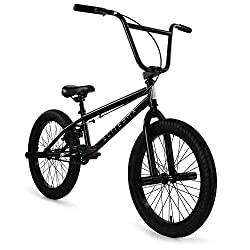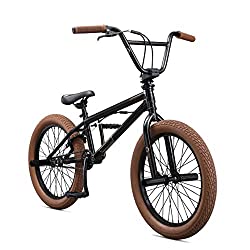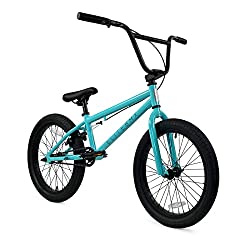BMX bikes come with one gear, which gives the impression that they are single-speed. But still, fixed-gear bikes also have one gear, which puts you in this dilemma: are BMX bikes fixed gear or single speed?
BMX bikes are not fixed gear! They are single gear, and the reason for that is that they have a freewheel that allows the rear wheel to turn when you stop pedaling, but the pedal arms (or cranks) don’t. The exceptions, however, are custom-made BMX bikes, which are fixed gear.
I understand how confusing it can be to establish if a BMX is single gear or fixed gear. For that reason, I will explain the differences between the two gearings. Once we establish the difference, we’ll conclude if BMX bikes are fixed gear or single speed.

What Is a Single-Speed Bike?
Single-speed bikes have a freewheel which allows one-direction movement. In that case, the rear wheel continues to turn when you stop pedaling, but the pedals’ arms or cranks don’t.
That also means you cannot stop the bike by stopping to pedal as the rear wheel will continue moving. And since you cannot brake by stopping to pedal, the bike needs brakes.
The other thing worth noting is that since a freewheel allows one-direction movement, you can only pedal forward and not backward.
What Is a Fixed Gear Bike?
Unlike single-speed bikes, fixed-gear bikes (or fixies) don’t have a freewheel. Instead, their rear cogs are fixed onto the rear hub to form one piece. As a result, once you stop pedaling, both the rear wheel and pedal arms/cranks turn.
So, there is no coasting (free moving without pedaling) as it’s the case of single-speed. And since there is no coasting. You can brake by simply stopping to pedal, which removes the need for brakes.
So, yes, you don’t need brakes when riding a fixie. You can not only brake by not pedaling but also by touching your legs on the ground or by changing your body position.
Note, however, that it takes time to master these braking maneuvers, and that’s why some riders prefer to have their fixies custom-made with brakes even though they aren’t necessary.

What’s The Difference Between Fixed Gear and Single-Speed Bikes?
Here’s how single-speed bikes compare with fixies:
a) Coasting
Coasting refers to the free-rolling of the bike without pedaling. Given that single-speed bikes have a freewheel, the rear wheel continues turning when you stop pedaling, which means they encourage coasting.
In contrast, the lack of a freewheel in a fixie means the rear wheel stops turning when you stop pedaling. So, a fixed-gear bike doesn’t allow coasting.
b) Braking
The lack of coasting on a fixie means the bike easily comes to a stop or slows down when you stop pedaling. Alternatively, you can bring the bike to a stop using your feet once you touch them on the ground.
Experienced bikers, however, change their body position when they want to slow down. In essence, you don’t need brakes to ride a fixie. That’s, however, not the case for a single-speed.
Since single-speed bikes allow coasting, you cannot stop the cycle just by stopping to pedal. The rear wheel will continue rolling even if you stop pedaling.
You may also have a hard time trying to touch the ground with your feet without engaging the brakes. As a result, brakes are necessary for single-speed bikes.
c) Pedaling Direction
Single-speed bikes can only move forward when you pedal forward and not backward due to the freewheel mechanism. But when it comes to fixies, their lack of freewheel and coasting means you can pedal backward and forward.
That explains why fixed gear bikes are standard on racing tracks and velodrome.
d) Ease of Riding
Single-speed bikes are generally easier to ride, even by beginners, because of the freewheel mechanism. While fixies become funnier to ride in the long run, you may have some difficulty initially.
So, fixies are not beginner-friendly. After all, their stopping depends on your foot power and not the brakes.
e) Bike Speed
Since a single-speed allows coasting, it saves you from pedaling all through. That means you are likely to move at the same speed, thus faster.
A fixie, in contrast, depends on your pedaling, and once you don’t pedal, your bike slows you down. So, you are unlikely to go at a higher speed.
f) Bike Control
Fixies generally require more rider involvement in their control. You have to be actively involved in balancing and bringing the bike to a stop. That’s unlike a single-speed which allows coasting without too much rider participation.

Now, Are BMX Bikes Fixed Gear or Single Speed?
From the above comparison, it’s irrefutable that BMX bikes are single-speed.
Here are the reasons I argue so:
1. BMX Bikes Have a Freewheel
BMX bikes have a freewheel mechanism that enables the rear wheel to continue rolling after pedaling (what we call coasting). And because of the freewheel, it lacks the derailleurs and other components that may vary its gear ratio.
2. BMX Bikes Are Brake Dependent
Though it doesn’t apply to all BMX bikes, single-speed bikes don’t stop when you stop pedaling, which means brakes are necessary. That’s what happens with BMX bicycles.
Their gearing system encourages coasting, which means you can’t just stop by the bike by stopping to pedal – brakes are unnecessary.
Note, however, that most BMX bikes only have the rear brake and lack the front brake. Only a few BMX bikes have brakes on both wheels. Overall, the rear brakes enable the bike to slow down and offer more control.
3. BMX Bikes’ Pedals Are One-Direction
Only fixed gears allow the pedals to move forward and backward when pedal. That’s, however, not the case with BMX bikes.
Remember, the crank stops turning when you stop pedaling when it comes to single-speed bikes. That’s what happens with BMX bikes. In that case, the pedals only respond to forward pedaling.

The Exception (BMX Bikes Fixed Gear)
While standard non-customized BMX bikes are single-speed, custom-made options come with fixed gears. Overall, it depends on what you want.
If you want BMX bikes with fixed gear, you have to ask the manufacturer to make one for you. Otherwise, you can get a fixed-gear bike, which comes single-speed like a BMX.
Do BMX Bikes Have Gears?
BMX bikes are single-speed, which is another way of saying they have one gear. Their gear ratio, however, varies from bike to bike.
Essentially, older models have bigger gearing ratios such as 44/16, while newer models have smaller gear ratios such as 23/8, 22/8, and 25/9.
Generally, smaller gear ratios promote a smoother gearing experience than bigger gearing rations, even though they experience extra grinding.
What’s the Best BMX Bike Gearing Option?
The best BMX gearing ratio for BMX include the following:
- 44/16 Ratio (2.75:1)
The 44/16 gearing allows you to ride BMX faster and accelerate quicker. The only issue is that it has a much lower max speed. As a result, this gearing is best for leisure riding and commuting but not for competition.
It’s also only best for flats.
- 30/11 Ratio (2.73:1)
According to experts 3:11, gearing is perfect for riders who like grinding. It makes pedaling more manageable and allows you to perform high-risk stunts.
- 25/9 Ratio (2.78:1)
The 25/9 gearing is a smaller gear ratio that makes pedaling seamless. It’s beginner-friendly and generally allows you to ride faster.

People Also Ask (About BMX Bikes Fixed Gear)
1. Are BMX Bikes Single Speed?
Yes, BMX bikes are single-speed. They have a freewheel that allows you to coast (roll freely when not pedaling). Overall, their coasting advantages make them faster, especially on flatter ground.
2. What Are the Different Gearings of A BMX?
BMX bikes have different gearing options, with the most popular ones being 44/16 (best for leisure riding), 30/11 (best for grinding), and 25/9 (best for beginners). Others include 23/8, 27/9, 30/9, 33/12, and 36/16.
3. Do Any BMX Bikes Have Gears?
BMX bikes are generally one-speed. They, however, have varying gear ratios, which promise different cycling experiences. The commonest gearing ratios include 44/16, 23/8, 25/9, and 30/11.
4. Can You Tell If a Bike Is a Fixed Gear?
Yes, you can tell a fixed-gear if its rear cog is fixed onto the rear hub, thus lacking a freewheel. The bike is not fixed gear but single-speed if the freewheel is present.
Also, you can tell a fixie from the pedaling experience. If it allows coasting (free rolling when you stop pedaling), then it’s not fixed gear.
5. Are BMX Bikes Hard to Ride?
BMX bikes come in single speed, which makes them comfortable to ride. So, no, BMX bikes are not hard to ride, especially on flatter surfaces. However, you may find them challenging and uncomfortable to ride on rougher terrains and hills as there is no shifting.
6. Are Fixed Gear Bikes Illegal?
Fixed-gear bikes are illegal in most places like the U.K when they are ridden on public roads and highways without front brakes. So, provided that the bike has brakes on both wheels, it’s not illegal to ride.
Relevant:
Are BMX Bikes Fixed Gear? Closing Thought:
The answer to this question is NO! No, BMX bikes are not fixed gear as they have a freewheel. Instead, they are single-speed, and the gearing enables them to coast seamlessly but makes them brakes-dependent.